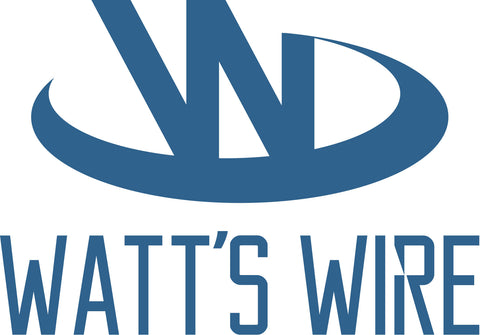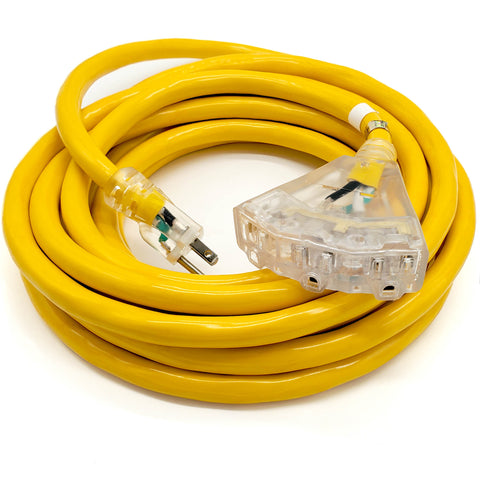- What makes Watt's Wire cords better than some competitors?
- We take pride in our products and do try and always have the best cords out there.
- Our indestructible Receptacles/ends are solid filled PVC.
- We use heavier coatings/jackets on most of our products.
- Our SJTW cords have an additional clear PVC coating that provides an easier to clean cord which is more resistant to abrasive environments.
- We include a lifetime warranty on manufacturing defects on most of our products.
- We offer a 30-day, no questions return policy. Just ship your cord back to us in the 30-day window and we will refund your purchase in full.
- We will work with you on selecting the right cord for your application.
- What are your extension cord's conductors made from?
- We utilize 100% pure soft drawn copper conductors for maximum conduction in all our products.
- What does SJTW or SJEOW mean?
- "SJ" stands for Service Junior (meaning 300V rated service cable)
- "T" stands for Thermoplastic Jacket (meaning PVC jacket)
- "E" stands for Thermoplastic Elastomer Jacket (meaning TPE jacket)
- "W" stands for Weather and Water Resistant (Outdoor rated cable)
- "O" stands for Oil Rated
- Put it all together:
- SJTW stands for a 300V rated PVC Outdoor Extension Cord.
- SJEOW stands for a 300V rated TPE Oil Resistant Outdoor Extension Cord.
- When should I use a GFCI cable?
- A GFCI cable should always be used when the cord or anything in contact could come into contact with water. A good rule is, if it is being used unprotected outdoors or in damp areas, use a GFCI protected receptacle, breaker or extension cord.
- OSHA does state that a GFCI is required when an extension cord is used for construction (or construction like) activities.
- It is okay to plug a GFCI extension cord into a GFCI outlet?
- Yes, multiple GFCI will not prevent the cord from working, but will add additional layers of protection.
- The cord says it is outdoor rated, but the package says do not use near water. What is going on?
- The cord itself is water proof, but the standard 3-prong power connectors used in North America are not waterproof and should always be protected accordingly.
- Using an extension cord near water is always a reason for concern and should be avoided.
- What is the right gauge of cable for me?
- This all comes down to current draw, the amount of power being pulled through the cord. The more power the device(s) plugged into the cord and the longer the cord, the heaver gauge you will want.
- Voltage drop increases when the gauge of conductor decreases. The voltage drop using a 10 gauge cord is one quarter that of the voltage drop of a 16 gauge cord over the same distance. Using a 15A load and 100ft cord, a 16awg cable loses 20% of the voltage compared to a 10awg losing only 5%.
- Plugging a generator table saw, air compressor, chop saw into a 100' cord, you will likely want to use a 10 gauge cord (10 gauge or awg is a larger cable than 12awg and 12awg is larger than 14awg).
- 12 gauge up to 100ft in length are good for most tools.
- 14 gauge up to 50ft in length are good for most tools.
- We do not recommend 16 gauge cords for any purpose. The NEC limits them to 10amps and recommends 25ft or less.
- 10 Gauge cabling in my house can handle 30 amps, why is the cord only rated to 15 amps?
- The cord is only rated to the component with the lowest amp rating. In this case (along with all other normal extension cord) it is limited by the plug. The 3-prong plug used commonly in North America can only handle 15 amps maximum. This is why we rate our cords to 15 amps maximum, even though the cord itself could handle up to 30amps.
- My breaker is tripping when running a tool, what is causing this?
- This may be indicating a safety concern. Never overload a breaker, circuit, receptacle or extension cord. Double check the circuit and cord ratings and correct any issues.
- The devices plugged into that circuit are overloading the breaker/wiring. Move some devices plugged into the circuit to a different circuit/breaker/receptacle and try again.
- There are too many devices plugged into the extension cord drawing too much power. Remove some devices and try again.
- If the device is tripping the breaker when you are turning on a motor, it could be due to high inrush current. Using a heavier gauge cord could help alleviate the inrush current causing the spurious breaker trip. First, make sure no other devices are on the same breaker/circuit/cord.
- What is the difference between 2-prong and 3-prong extension cords?
- 2-prong cords do not have a grounding conductor. A grounding conductor allows a device to have a dedicated path back to ground in the event of a short. Therefore, these should never be used with a device that requires a 3-prong power plug. Adapters that convert a 3-prong to a 2-prong should never be used.
- I have a warranty question, where do I go from here?
- We may require pictures, model number, date of purchase and receipt to honor warranty claims.
- We will review each case and will provide a RMA number and an address for you to ship the damaged product (at your cost) to our office to review/repair/replace.
- Please use the contact us page to start a warranty claim for your RMA number before sending the cord to us.
- Why do I see a spark when I plug a device into an extension cord.
- A spark is indicating that current is flowing. To prevent this, always turn off the device before plugging in or unplugging a device. The spark is not dangerous when contained within the plug itself, but can cause pitting on the connector terminals and could lead to premature failure.
- What are some good safety tips to keep in mind?
- Always inspect an extension cord prior to use for any signs of damage. Discard or properly repair before using a damaged cord.
- Never leave an extension cord plugged in for over 30 days and do not substitute permanent wiring for an extension cord when for a permeant device.
- Never allow an extension cord to come into contact with water.
- Always grasp the plug and securely insert the plug or unplug the cord.
- Never use an indoor rated extension cord outdoors.
- Know when to use a GFCI protected cord, and when in doubt, default to using a GFCI.
- Extension cords do not have integral current limiting devices. It is up to the user to prevent overloading the extension cord. Pay close attention to the power rating of the cord and what it is being used for. Do not ever overload an extension cord.
- Never install under rugs, furniture, underground, or where they may be a tripping hazard.
- Can I plug my space heater, refrigerator, freezer, power tool, etc. into my cord?
- The first thing is to always check your cord’s max load, and the device(s) total load/power consumption!
- That can be a tough question without knowing the required power of your appliance. The short answer is most likely yes.
- MOST common devices that you can plug into your standard outlet in your home, you can safely plug into our extension cords. Be careful when plugging multiple items into one cord. To be sure, follow these instructions:
- All our 12 gauge and 10-gauge cords are rated to handle max 1875Watts, 15Amps. Our cord reel and 14-gauge cords longer than 50ft, are rated for max 1625Watts, 13Amps.
- Check the device(s) you are plugging into the cord. Look for their wattage rating/usage. If the device(s) combined power usage is equal or less than what the cord it rated for, than yes, you can plug them in without issue.
- For example: If you are using our 12-gauge 15ft single outlet cord, it is rated for 1875Watts, 15Amps.
- If you plug in a space heater that requires 1500Watts, you would be safe in doing so.
- If using the same cord but with the triple outlet, you would be safe to plug another SMALL device into the cord as well, so long as it uses less than 375Watts. (1500+375 = 1875 total watts)
- If the device(s) you are using measuring their power usage in Amps, add the total Amps of the device(s) up and do not exceed 15Amps.




